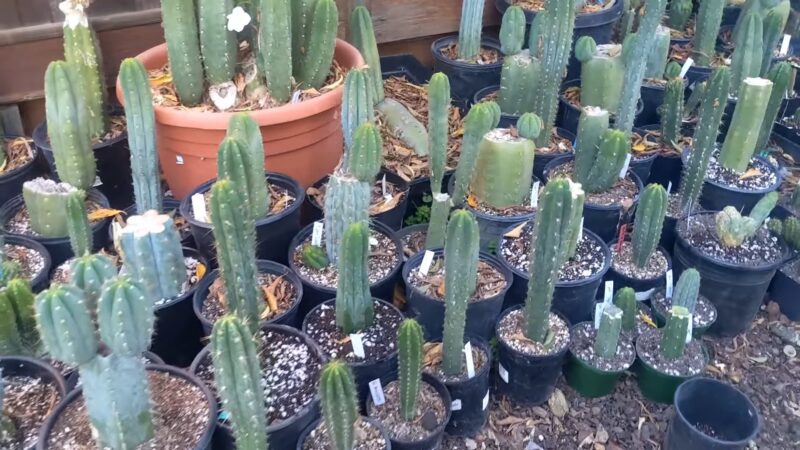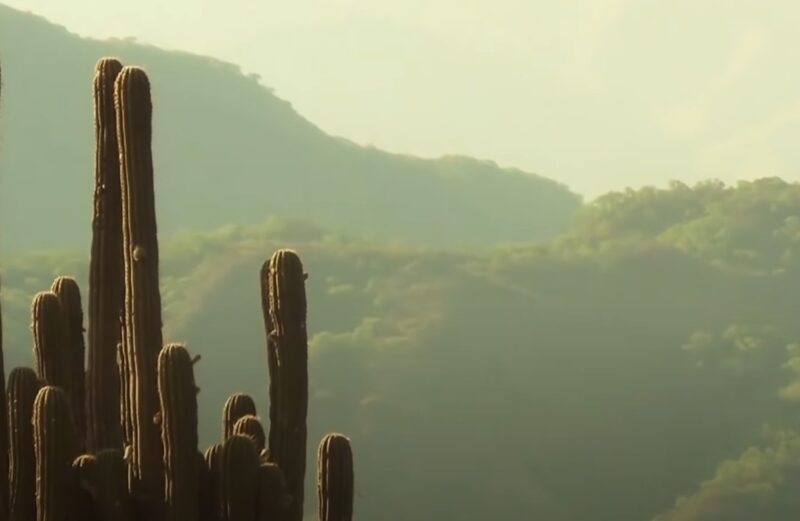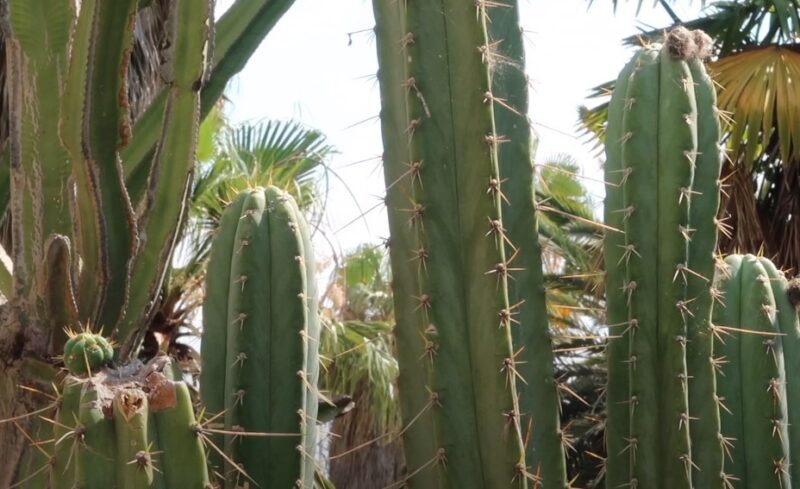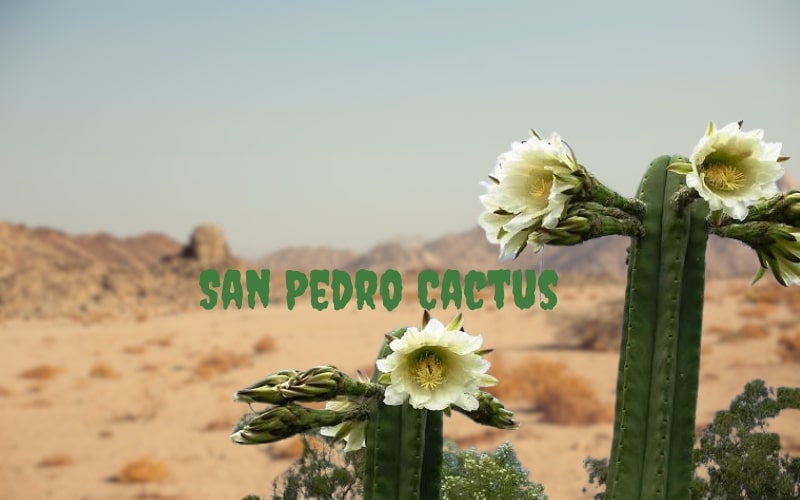Hey there! If you’ve stumbled upon this article, you’re probably curious about the San Pedro Cactus. Well, you’re in for a treat! Let’s dive right in.
San Pedro Cactus, scientifically known as Echinopsis pachanoi, is a fast-growing columnar cactus native to the Andes Mountains. It’s been around for ages, and trust me, it’s not just any ordinary cactus.
This cactus isn’t just about its looks. It holds deep cultural and historical significance, especially among indigenous communities in South America. For centuries, it’s been used in traditional ceremonies and rituals.
🌵 Fun Fact: The name “San Pedro” translates to “Saint Peter” in English. Legend has it that the cactus was named so because it’s believed that Saint Peter holds the keys to heaven, and this cactus could spiritually “unlock” visions and insights.
Botanical Description

Alright, let’s get a bit science-y here, but don’t worry, I’ll keep it light!
| Kingdom | Plantae |
| Division | Magnoliophyta |
| Class | Magnoliopsida |
| Order | Caryophyllales |
| Family | Cactaceae |
| Genus | Echinopsis |
| Species | E. pachanoi |
San Pedro Cactus is a tall, green, and ribbed columnar cactus. It can grow multiple arms or branches, and it’s covered in tiny, white spines. The cactus also blooms beautiful white flowers, but only at night!
This cactus is a fast grower! In its native habitat, it can reach heights of up to 20 feet. However, when cultivated in gardens or homes, it usually grows between 3 to 5 feet tall.
💡 Pro Tip: If you’re thinking of adding a San Pedro Cactus to your garden, remember that it loves sunlight. However, young plants might need some shade during the hottest parts of the day.
Native Habitat and Distribution

Ever wondered where this magnificent plant naturally thrives?
San Pedro Cactus is native to the high-altitude regions of the Andes Mountains, spanning across countries like Peru, Ecuador, and Bolivia.
Being a mountain native, this cactus is adapted to cooler temperatures and high altitudes. It’s pretty resilient and can handle temperatures as low as 15°F (-9°C) for short periods. However, it thrives best in temperatures ranging from 50°F to 80°F (10°C to 27°C).
| Climate Factor | Ideal Condition |
| Temperature | 50°F to 80°F (10°C to 27°C) |
| Rainfall | Moderate, but well-draining soil is a must! |
| Altitude | High altitude regions |
🌵 Fun Fact: San Pedro Cactus has a unique ability to store water, allowing it to survive long periods of drought. This makes it a perfect plant for xeriscaping, a landscaping method designed to reduce the need for irrigation.
Traditional and Contemporary Uses
The San Pedro Cactus has been revered by indigenous cultures for millennia. It’s been a central figure in many spiritual and healing ceremonies. Shamans, or traditional healers, often use the cactus to communicate with the spirit world and to heal various ailments.
💡 Pro Tip: If you ever get a chance to participate in a traditional ceremony involving San Pedro, approach it with respect and an open mind. It’s a deeply spiritual experience for many.
In traditional rituals, the cactus is often boiled or brewed into a drink called “huachuma.” Participants consume it in a ceremonial setting, often guided by a shaman, to embark on a spiritual journey.
Today, there’s growing interest in the potential therapeutic benefits of San Pedro. Some researchers and therapists are exploring its use in treating conditions like depression, anxiety, and PTSD. However, it’s essential to approach this with caution and under professional guidance.
Cultivation and Care
Thinking of growing your own San Pedro? Here’s what you need to know!
San Pedro Cactus loves sunlight, but young plants might appreciate some shade during the hottest parts of the day. They prefer well-draining soil and should be planted in pots with drainage holes.
| Growing Factor | Recommendation |
| Soil Type | Sandy, well-draining |
| Sunlight | Full sun to partial shade |
| Pot Type | With drainage holes |
🌵 Fun Fact: San Pedro Cactus can grow up to 12 inches a year under optimal conditions!
You can propagate San Pedro from seeds or cuttings. Using cuttings is the most common method. Simply cut a section of the cactus, let it dry for a few days, and then plant it in soil.
Water the cactus sparingly. It’s better to underwater than overwater. During the growing season, you can fertilize it once a month with a cactus-specific fertilizer. Keep an eye out for pests like mealybugs and treat them promptly.
Psychedelic Properties
Now, onto the part many are curious about: the psychedelic properties of San Pedro.
The primary psychoactive compound in San Pedro is mescaline. This alkaloid induces altered states of consciousness, visions, and introspective experiences.
💡 Pro Tip: Mescaline is also found in other cacti like the Peyote. However, the concentration and effects can vary between species.
When consumed, San Pedro can induce a range of effects, from mild euphoria to profound spiritual experiences. Users often report enhanced perception, deep introspection, and a heightened sense of connection to nature.
While many have positive experiences with San Pedro, it’s not without risks. It can cause nausea, increased heart rate, and disorientation. It’s crucial to use it responsibly, ideally under the guidance of someone experienced.
Harvesting and Preparation

The best time to harvest San Pedro is during its active growth phase, which is typically in the warmer months. A mature cactus, around 3-5 years old, is ideal for harvesting.
💡 Pro Tip: Early morning is the best time of day to harvest, as the cactus is full of energy and its alkaloid content is at its peak.
When harvesting, use a sharp, sanitized knife to make a clean cut. Ensure you leave at least a few inches of the cactus base so it can regrow.
| Step | Instruction |
| 1 | Choose a mature, healthy cactus. |
| 2 | Sanitize your knife or cutting tool. |
| 3 | Make a clean cut, leaving some base. |
Once harvested, remove the spines and outer skin. The inner flesh can be dried and ground into a powder or boiled to make a brew. Always remember to use responsibly and be aware of the potency.
Legal Status and Cultural Respect
Navigating the legal landscape of San Pedro can be tricky, so let’s break it down.
The legality of San Pedro varies by country. In some places, the cactus is legal to grow but not to consume, while in others, both cultivation and consumption might be prohibited.
| Country | Legal Status |
| USA | Legal to grow, illegal to prepare/consume for psychedelic properties |
| Canada | Legal to grow, mescaline is a controlled substance |
| UK | Legal to grow, illegal to prepare/consume for psychedelic properties |
🌵 Fun Fact: While the cactus itself is legal in many places, the extraction or consumption of its psychoactive compound, mescaline, might be prohibited.
It’s essential to approach the use of San Pedro with respect for its cultural and historical significance. If participating in traditional ceremonies, always do so with an open heart and mind, showing reverence for indigenous customs and traditions.
Conservation Efforts

With increasing popularity, there’s a growing need to protect the San Pedro Cactus.
Overharvesting, habitat destruction, and climate change are significant threats to the wild populations of San Pedro.
💡 Pro Tip: If buying San Pedro, ensure it’s sourced sustainably. Supporting local, ethical growers can make a difference.
Several conservation groups are working to protect the San Pedro Cactus and its natural habitat. Efforts include habitat restoration, sustainable cultivation practices, and raising awareness about the cactus’s significance.
| Conservation Measure | Description |
| Habitat Restoration | Replanting and rehabilitating areas where San Pedro grows naturally. |
| Sustainable Cultivation | Encouraging growers to adopt practices that don’t harm wild populations. |
| Education & Awareness | Spreading knowledge about the importance and cultural significance of San Pedro. |
FAQ
Is San Pedro Cactus legal in my country?
Legality varies. Always check local regulations before cultivation or consumption.
What are the main active compounds responsible for its effects?
Mescaline is the primary psychoactive compound.
Can San Pedro be grown indoors?
Yes, with proper lighting and care.
How do I prepare San Pedro for consumption safely?
Remove spines, skin, and consult experienced guides.
Are there any potential side effects or risks?
Yes, including nausea and disorientation. Always use responsibly.
What cultural considerations should I keep in mind when using San Pedro?
Respect its indigenous roots and traditional ceremonies.
How can I contribute to the conservation of the San Pedro Cactus?
Support sustainable growers and conservation initiatives.
Conclusion
As we wrap up our journey exploring the San Pedro Cactus, it’s evident that this plant is more than just its psychedelic properties. It’s a bridge between the past and present, nature and culture.
Whether you’re a gardener, researcher, or someone curious about traditional practices, always approach the San Pedro Cactus with respect and reverence. Here’s to understanding, appreciation, and responsible exploration!


